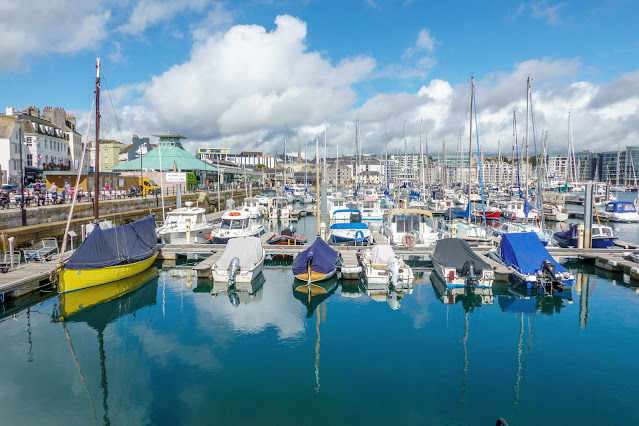Plymouth - a day by the Ho
We had been looking forward to visiting Plymouth and found ourselves blessed with lovely weather today. We left the car at a Park & Ride and got off at The Barbican, which is the name given to the western and northern sides of Sutton Harbour, the original harbour of Plymouth in Devon, England.
Boats in Sutton Harbour
The Mayflower Steps is a commemoratve area in honour of Pilgrim Fathers who set sail for the New World in 1620. I think this spot is symbolic rather than the actual spot.
The Leviathan or Barbican Prawn
The Barbican Prawn standing 33ft tall and unveiled in 1996. Official name The Leviathon
El Galeon. 17th Century Spanish Galleon Replica
The huge ship which sailed into Plymouth in September and moored at Barbican Landing Stage. The full-size replica of a 17th century Spanish galleon was original due to visit the city in August, but it was postponed due to the bad weather. Since September 13, visitors have been exploring the 'living museum', which was scheduled to leave on September 17. But as Plymouth is its last port of call on its summer-long tour of some of Europe's most important ports, it was able to extend the visit. Lucky to see this as it was still there on the day we visited.
Then we continued our walk along Plymouth Hoe as there were plenty of attractions we thought.
The two guns situated on the Hoe are restored ships’ cannons from the 19th century. They may have seen action during the Crimean War (1853 – 1856) or during one of the many Naval expeditions that Britain undertook during the 19th century. The gun carriages are replicas.
Part of the old citadel walls
Drake Island
Tinside Lido - what a fabulous spot.
Royal Marine Memorial
There are several memorials in this area as I guess it's a good visitor and viewing area.
Welcome to Plymouth
A centrepiece on Plymouth's Hoe, Smeaton's Tower has become one of the South West's most well-known landmarks. The lighthouse was originally built on the Eddystone reef in 1759 at a cost of £40,000 but was taken down in the early 1880s when it was discovered that the sea was undermining the rock it was standing on. Approximately two thirds of the structure was moved stone by stone to its current resting place on the Hoe.
RAF and Allied Air Forces memorial
Armada memorial
Frances Drake
Sir Francis Drake (c. 1540 – 28 January 1596) Born in Tavistock.was an English explorer and privateer best known for his circumnavigation of the world in a single expedition between 1577 and 1580. This was the first English circumnavigation, and third circumnavigation overall. He is also known for participating in the early English slaving voyages of his cousin, Sir John Hawkins, and John Lovell. Having started as a simple seaman, in 1588 he was part of the fight against the Spanish Armada as a vice-admiral. He served as mayor of Plymouth in 1582. and MP/in 1583
Plymouth Navel Memorial
Then we walked past a bowling Green (Frances Drake?) and back toward our bus stop. As luck would have it, we came upon an enormous statue which I had spotted on the way in.
Just to give an idea of its size, Rosey is almost underneath when I took this image. Messenger is a large statue in Plymouth, UK, created by the Cornish artist Joseph Hillier, depicting a female actor crouching in preparation to run onstage. It was commissioned by and installed outside the Theatre Royal, Plymouth in 2019 in preparation for the city's Mayflower 400 celebrations.
A really interesting day with plenty of historic reminders.




















Comments